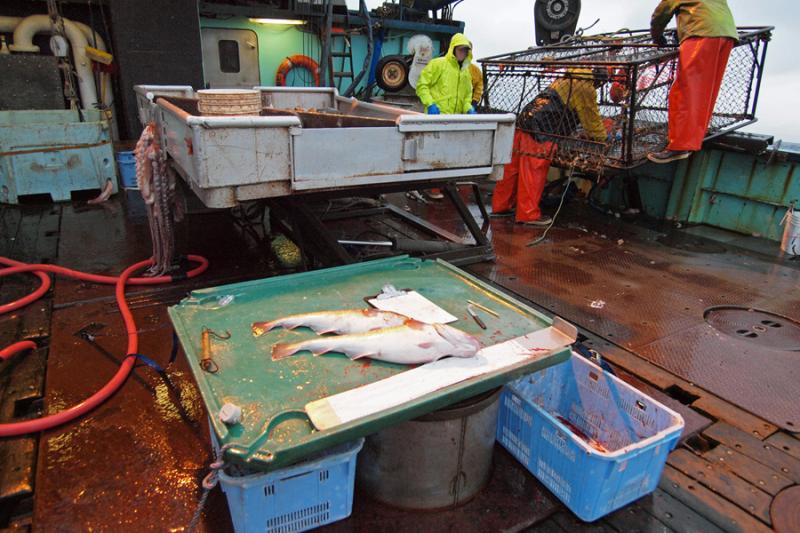Each year NOAA Fisheries scientists collaborate with fishing industry partners to develop a deployment plan for the Alaska fishing fleet. The challenge is to assign observers and electronic monitoring (EM) to vessels and processing plants in a way that gathers statistically reliable data while remaining cost-effective. Right now, Alaska Fisheries Science Center scientists are meeting with the North Pacific Fishery Management Council to set a deployment plan for 2022—and beyond.
“This year we’re doing something very different from any other year. We want to choose a strategy for 2022, and keep it for 2023,” said Jennifer Ferdinand, Director of the Alaska Fisheries Science Center Fisheries Monitoring and Analysis Division. “That will give us time and opportunity to integrate all of the factors that affect our coverage. We want to evaluate our plans and agree that this is the right approach.”
The North Pacific Observer Program plays a fundamental role in the sustainability of Alaska’s valuable commercial fisheries. The program deploys human observers and EM on fishing vessels and in processing plants. They collect some of the high quality scientific information needed to manage Alaska groundfish and Pacific halibut. These fisheries are widely recognized as some of the best-managed in the world.
Multiple Programs Enable Cost-Effective Coverage
To meet both scientific needs and financial constraints, the observer program has evolved to become more complex in the past decade.
“Prior to 2013, we had one observer program. Now we are running four separate programs,” Ferdinand said.
The annual deployment plan explains how NOAA Fisheries intends to assign observers and EM to vessels in the partial coverage categories for observers and EM.
“The deployment plan ensures that we have a statistically robust deployment model any time we can’t put an observer out full-time,” Ferdinand said.
Challenges to Meeting Data Needs
Among the many complexities the team must consider in developing deployment strategies are a number of new and ongoing issues.
Plans must meet budgets that have not been stable over the years. All monitoring in Alaska’s groundfish and halibut fisheries is industry-funded. For the partial coverage fleets, a fee is collected to pay for observers and EM. Therefore revenue depends on fishing activity and market prices, which change from year to year.
Expanding EM means that we obtain fewer biological samples that human observers collect from discarded catch. These include length, weight, diet, sex and sexual maturity of fish. They tell us valuable information about the age of the fish and reproduction for fishery assessments. Deployment models must integrate the information that EM can collect with what only observers can collect.
“Any adjustments to the deployment plan must be weighed carefully, since there are so many people counting on the data collected by observers and EM,” Ferdinand said.
The Planning Process
The Annual Deployment Plan process ensures that the best available information is used to evaluate deployment. This includes scientific review and North Pacific Fishery Management Council input.
“By March we have all our data from the previous year of fishing. We review and evaluate it. How were resources deployed? How did those choices affect the data?” Ferdinand explained. “The results are published in the North Pacific Observer Annual Report in May. We use that information to help with our planning for the next year.”
Some of the questions the team asks to develop strategies for the following year include:
- What will fishing effort be in the following year?
- What will the budget be for deployment?
- How might we allocate afforded samples?
- What vessels will be participating in fixed gear and trawl EM?
This year, the team developed four alternative strategies. They evaluated them to determine the pros and cons of each allocation plan.
In the fall, NOAA Fisheries scientists present their recommendations to the North Pacific Fishery Management Council. Working together with the Council, they finalize the plan by December. In January, they implement the new deployment plan.
Recommendations for 2022 (and Beyond)
NOAA Fisheries’ 2022 plan uses the 2021 plan as a starting point. Due to the COVID-19 pandemic, observer coverage had been restricted to protect all fishery participants and the communities in which they operate. Coverage has now been expanded in accordance with Alaska health advisories and because the vast majority of observers are now vaccinated.
The 2022 plan recommended by NOAA Fisheries will meet the goal of achieving a minimum of 15 percent coverage for the partial coverage fleet. It will send additional resources where the data needs are greatest.
NOAA Fisheries supports ongoing testing of EM coverage for the pelagic pollock trawl fleet. They recommend collaborating with industry partners to explore and evaluate more cost-effective and mobile EM systems.
NOAA Fisheries recommends maintaining the 2022 deployment plan strategies through 2023. This approach will allow the team time to integrate analyses for the 2024 Deployment Plan.
“By developing plans in collaboration with our industry partners, we ensure that monitoring continues to meet both practical constraints and data needs to keep our fisheries sustainable,” Ferdinand said.






